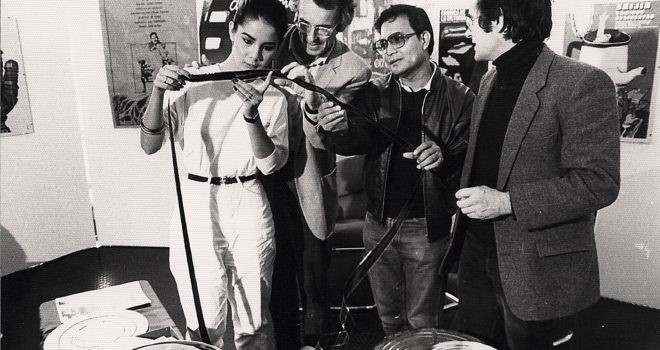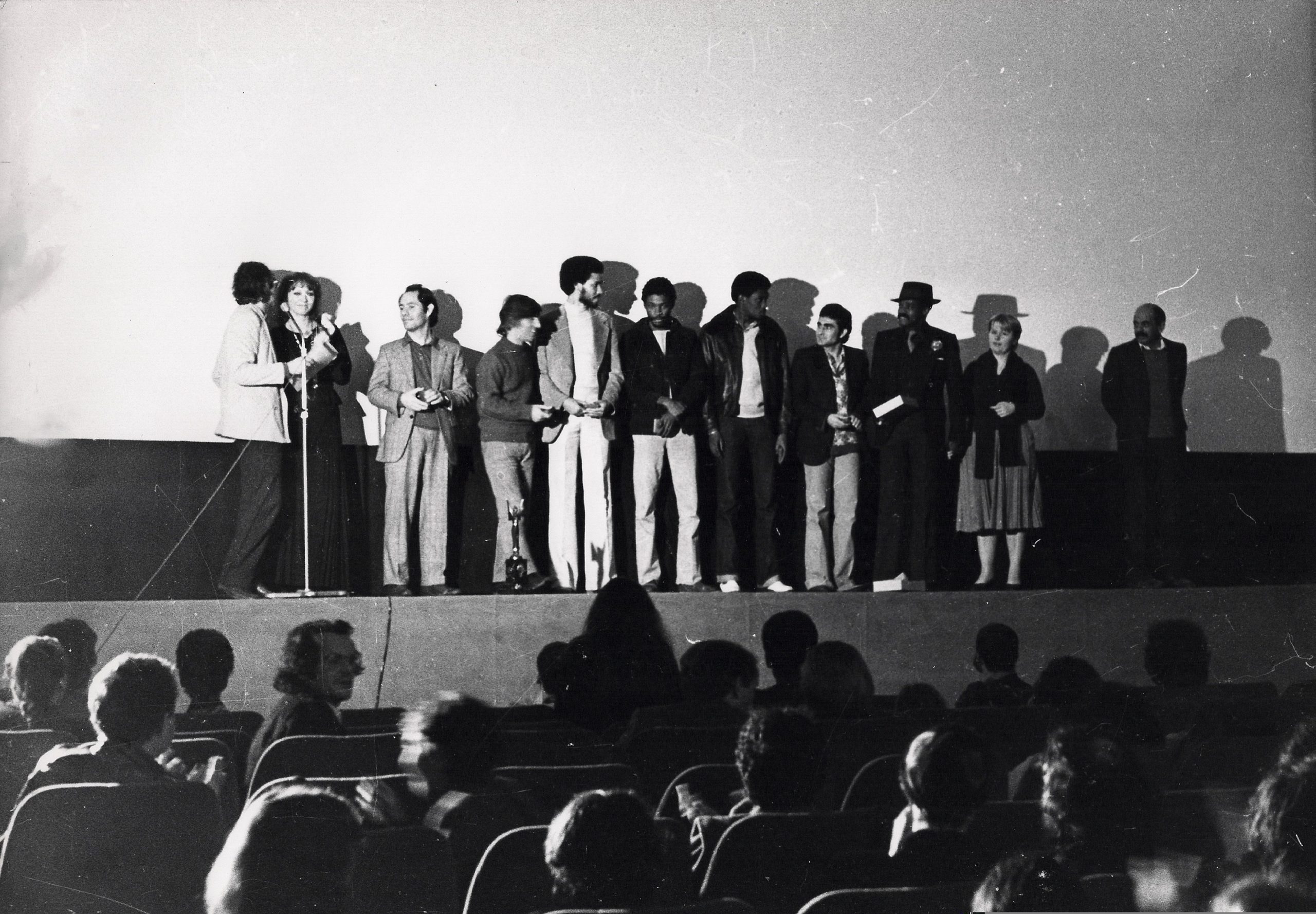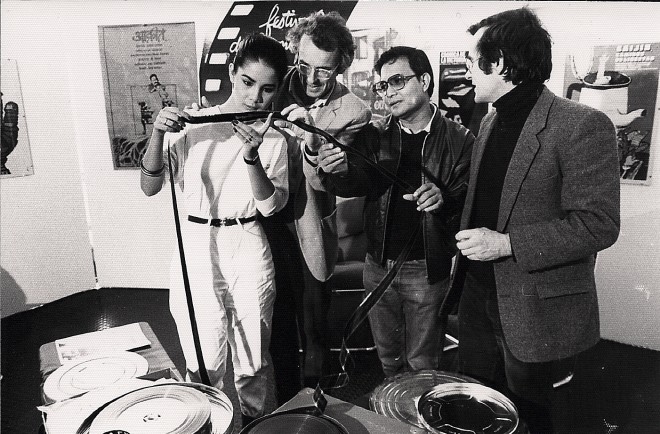Every year since 1979, at the end of November in Nantes, the 3 Continents Festival offers a different view of cinema and our world through a unique selection of fiction and documentary films from Africa, Latin America and Asia.
Home > The 3 Continents > About us
A pillar of cinephilia for more than 45 years, the Festival des 3 Continents showcase numerous works and essential filmmakers from Africa, Latin America and Asia and regularly offers retrospectives that are landmarks in Europe. At the same time, the Festival’s expertise is part of a movement of reflection on contemporary cinema and its evolution.
Some of the greatest names in international cinema have been revealed there, including Hirokazu Kore-eda (Japan), Souleymane Cissé (Mali), Hou Hsiao-hsien (Taiwan), Abbas Kiarostami (Iran), Wong Kar-wai (Hong Kong), Jia Zhang-ke (China), Wang Bing (China)…
“More than 40 years ago, this festival opened with a reference to Jules Verne as a world tour in seven days, an unusual journey for us immobile navigators, appealing to our curiosity, our passion for the unknown to watch and listen to these images and voices from three continents.”
Anne-Laure Joséphine, president of the 3 Continents association.
Each year, the festival is structured around the Official Selection, tributes or retrospectives, thematic programs and programs for young audiences.
The Official Selection combines an International Competition with films premieres, awarded with the Montgolfière d’Or and the Montgolfière d’Argent , a Youth Jury Award and an Audience Award, with a selection of special screenings.
For 20 years, the Festival des 3 Continents has been offering training workshops about the tools of international co-production to young professionals (directors, producers) from countries on three continents. Seven workshops are held around the world each year, providing a real incubator for new talents.
Since its creation, the Festival des 3 Continents has endeavored to make cinema accessible in all its diversity, bringing together popular and auteur films with the same concern for education open to all audiences, from the most cinephiles to the less experts.
by Alain et Philippe Jalladeau, founders of the festival – November 2008

Carmi Martin, Lino Brocka and the Jalladeau brothers
At the end of the 1970s, the cinema was emerging from years troubled by politics. The period of « everything is politics» was over and we could at last again say « cinema is an ART » and, above all, that there were artists to make it. Moreover, the third-world vision of the world allowed us to look at countries ignored by most, but reduced this opening to ideological and economic concepts. Thus, films favoured content over form, leaving aside the specific creation of a cinematographic language.
Read more
In Nantes, as in the rest of France, after the dark years following 1968, cinematographic activity started up again around 1972, leaving aside Marxist dialect and image semiology and focusing on creation and the notion of auteurs.
In accordance with its well-established auterist habit, France, until then, had showcased a few well-known creators from the 3 continents, while ignoring many others. Mizoguchi, Kurosawa (Japan), Satyajit Ray (India), Torre Nilsson (Argentina), Nelson Pereira dos Santos (Brazil), Emilio Fernandez (Mexico) were discovered thanks to a few, often the same films, which were shown in film societies before going out of fashion. Others took their place in the 1960s and 1970s, Nagisa Oshima from Japan, Lino Brocka from the Philippines, Glauber Rocha from Brazil, thanks to the (justified) lobbying of certain enthusiasts (eg. PierreRissient in the case of Brocka). Glauber Rocha, who was linked to Godard, formed part of the « Cinema Novo » cinematographic movement in Brazil, and was the only one, I believe, to have been able to promote himself in Europe. It should be said, for its misfortune, that the coup d’état chased many filmmakers from Brazil.
We were able to meet the Brazilian filmmakers present at the Venice Festival in 1969 and the Berlin Forum in 1972.
In general, filmmakers present at the 3 Continents had until 1979 only a partial, limited and fragmented presence in the rest of Europe, in conditions which gave them only much reduced visibility. Their films were eclipsed in international festivals by European and U.S. films, without mentioning their almost non-existent distribution.
Thus, the Cannes Festival in 1978 had programmed Bye Bye Brazil by Carlos Diegues on the same day as Apocalypse Now by Coppola which monopolized everybody’s attention. It was also at this time that we saw in Cannes the very beautiful film The Chess Players lost in a cinema in the rue d’Antibes in front of 10 people. Ray had been forgotten for a long time by the Cannes Film Festival, his masterpiece Charulata (The Lonely Wife) had been refused and Satyajit Ray hurt. He vowed never to return to Cannes, whereas the presentation of his first film, Pather Panchali had propelled him to the foreground. At the time, Embassies played a larger role than “auteurs” at the Festival.
 Satyajit Ray, in 1980 in Nantes
Satyajit Ray, in 1980 in Nantes
In 1978, we were invited to the Carthage Festival in Tunisia. That year, it widened its scope, usually limited to Africa and the Arab world, to Asia and Latin America. We were able, of course, to meet the Arab and African filmmakers, but also Venezuelans, Colombians and Sri Lankans. However, the festival was unfortunately overwhelmed by the political debates running through the Arab world at the time and the cinema was often forgotten. This tricontinental experiment was not followed up.
Thus the Festival des 3 Continents, a title inspired by the Spoleto Festival of the Two Worlds, an Italian theatre festival, was born but it in no way aimed to be a festival of the third world. The filmmakers, whether they were from Mongolia, Argentina, or Burkina Faso, were all treated equally and were not put in a 3rd category. Only their creative talent separated them, they expressed their cultures through their diversity, each country was required to produce its own images, the competition was to make it possible for the winning filmmakers to get international recognition and thus to help them continue their work in their own country. As the language of the cinema is universal, the international jury was to award the prize for cinematographic creation, above all else, outside of any political consideration.
The project obtained the support of the City of Nantes, which allowed the festival to be born in November. Its novelty meant that it was a gamble where success was not ensured, all the more so as the first programming was somewhat refined with the discovery of Afro-American filmmakers. A selection committee, composed of Catherine Ruelle, Claude Michel Cluny and Serge Daney helped us for this first unprecedented programme. 7,000 spectators saw the films, one of the most important being Louis Marcorelles, a journalist from Le Monde, who wrote an article full of praise for the front page of the newspaper.

The festival was on its way and as early as the Spring of 1980, we understood that it was going to be necessary to go out and explore on the ground directly if we were to discover films and filmmakers. It is true that at the beginning, influenced by the policy of the authors of the Cahiers du Cinéma, we paid attention only to the filmmakers, ignoring completely producers and the economy of the cinema. Serge Daney who had travelled through India a few years before, advised us to go there, which we did.. There was a flourishing auteur cinema in the country and at each stage, we were amazed. In Calcutta,we met Satyajit Ray in his home and discovered the films of Ritwik Ghatak, which were a real eye-opener. At Trivandrum, in Kerala, in the south of India, we were received by Adoor Gopalakrishnan, who was surprised to see, for the first time in his life, the arrival of two young Westerners looking for films and filmmakers. He became our friend and persuaded us to put India in the programme for the 1980 edition.
1981 was one of the first somewhat foolhardy gambles of the Festival but still counts as an important date for the countries of the South. At the instigation of Pierre Rissient we envisaged a restrospective of the cinema of the Philippines. Indeed, he knew Lino Brocka well and the latter, enthused by our project, invited us to the Philippines to turn the programme into reality. On our arrival, we discovered that no films had been kept, nor were there any archives of course. The producers did not keep their “old” films, a name given to them when they were older than 2 years. Only Lino Brocka had been able to keep his own and a few others. Thanks to him and a critic historian, we were able to find some films little by little in the Philippines, but also in the countries with Filipino communities.
 Carmi Martin, Lino Brocka and the Jalladeau brothers
Carmi Martin, Lino Brocka and the Jalladeau brothers
Thus we were able to present a completely original programme but also contribute to the creation of the first film library in the Philippines and to the preservation of the films. 27 years later in Pakistan, history repeated itself, but the film library has not yet been created.
Without going into all the details of the years which followed, but which established the reputation of the Festival, the discovery in 1982 of the 2 exceptional Indian filmmakers, Ritwick Ghatak and Guru Dutt, unfortunately now deceased, for some people counts as one of the greatest and major moments of their lives as cinema lovers, among them Joao Bernard da Costa, the highly qualified director of the Lisbon film library who was present in Nantes in the jury.
During these early years, the 6th Festival des 3 Continents, in 1984 was a key date. Not only because we paid a tribute for the first time to an actor and actress who were famous in their own country: Samia Gamal, an Egyptian star and Raj Kapoor, an Indian filmmaker known from Morocco to China, including Russia, where he was worshipped, but who had never received a tribute in the West. That year, the jury awarded the prize to 2 major films: The Boys from Feng Kuei by Hou Hsiao-hsien from Taiwan which allowed him to become known as a great filmmaker and the Les Baliseurs du désert (Wanderers of the Desert) by the Tunisian Nacer Khemir, an UFO of fantastic realism touched by grace.
 Claude Sérillon, Hannah Schygulla and Hou Hsiao-hsien, winner of the Golden Montgolfière in 1985 for A Summer at Grandpa’s
Claude Sérillon, Hannah Schygulla and Hou Hsiao-hsien, winner of the Golden Montgolfière in 1985 for A Summer at Grandpa’s
1988 was an important year for the Festival. It was the year it definitively acquired the reputation of discoverer among Western professionals. For the competition, we selected a film from Iran by Bayram Beyzai. A little later, we received for viewing another film entitled Where is the Friend’s Home? The title was not really stimulating but the film had been made by Abbas Kiarostami, who was unknown in the West, but who had a good reputation in Iran – he had begun before the Revolution with a pretty film called The Traveller. The film we had viewed had made a very strong impression on us but as we did not at the time want to put 2 films from the same country in the Competition, it was selected out of competition. David Streif, at the time Director of the Locarno Festival, who was present in Nantes, immediately selected the film for his Festival. Kiarostami was launched internationally. He never came to Nantes with another film but he became our friend and presented, in his presence, a beautiful photographic exhibition in 2005.
During the 1990s, the Festival reached adulthood, the cinemas were full and above all professionals from all over the world came in the hope of discovering a rare pearl and new actors. European buyers and distributors wanted ever more films, that they could not see elsewhere. Should we set up a film market ? A least, wider programming ? We did not have the financial means and Nantes did not have the infrastructure adapted to such a project.
We had always thought that the cinema was an art and not so much an industry. We always looked upon filmmakers as creative artists. We had ignored producers. However, little by little, we realised that without them films could not be made. The filmmakers from the South often became their own producer so that they could make their films, but their lack of competence in the profession was a drawback. Thus, in spite Western aid, the auteur films in the South became more and more difficult to make. This is why in 2000, under the impetus of a young female French producer, who worked a lot with the countries in the South, came the creation of « Produire au Sud », a workshop for young producers from the South selected on the merit of their projects. Because it responds to a real need, this workshop has today gained such a success that it is exported throughout the world, but it cannot expand further in Nantes because of a lack of means.
In 2003, the Festival opened up to documentaries, thus offering us a new vision of the world, complementary to that of fiction, but sometimes so near to it that we may ask ourselves where the frontier lies. It is an exciting adventure for a whole part of the cinema of the 3 Continents that we are beginning to get to know.
Nowadays, in 2008, no doubt the romantic cinematographic adventures associated with the discoveries of unknown territories will be less numerous because globalisation allows films and people to travel. Information circulates in every direction, and emotion and desire diminish, since everything seems to be within easy reach, but the cinema is still alive and continues to be on the go, particularly in the 3 Continents and, even if we do not yet know what tomorrow will bring , the saga of the 3 Continents is not over and a new page will be written with the 30th festival.
However, as we assess what has been done, we might think that we could have made a « small big Festival », but because we above all liked films, were motivated by a continually renewed curiosity, supported from the first Festival onwards by a certain number of devoted associates who shared our passion, we have perhaps at least succeeded in creating a « big small Festival » which still benefits today from a large recognition throughout the world.